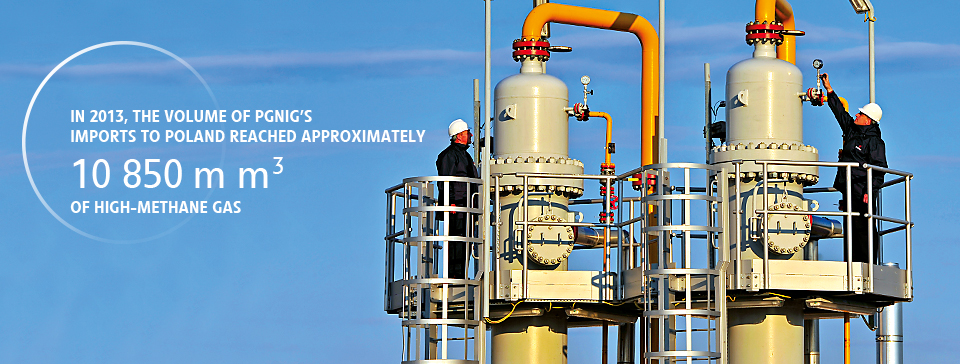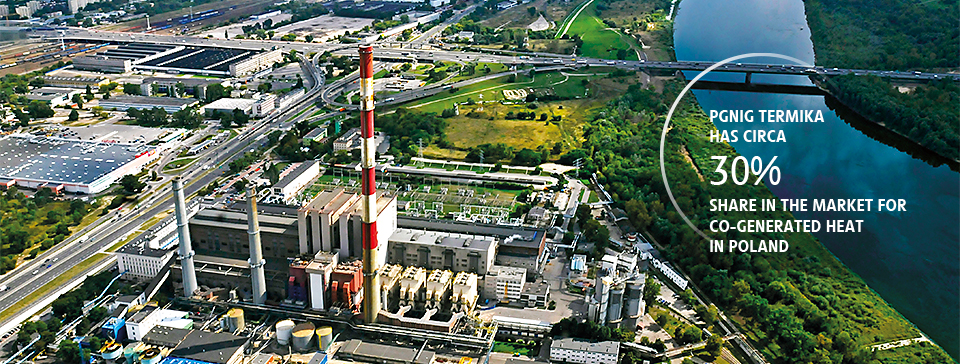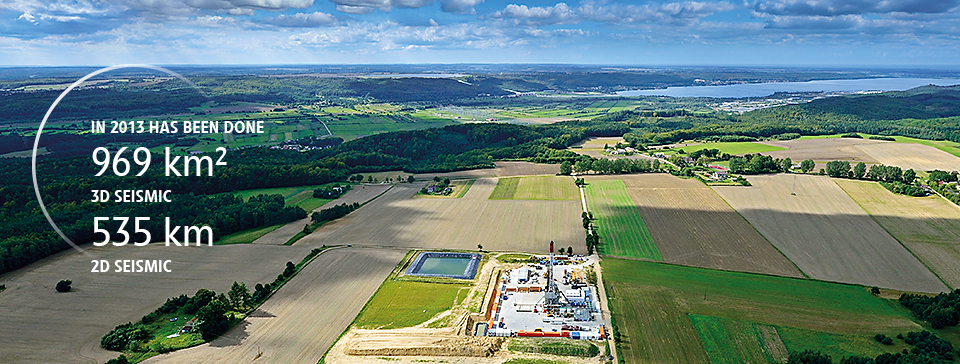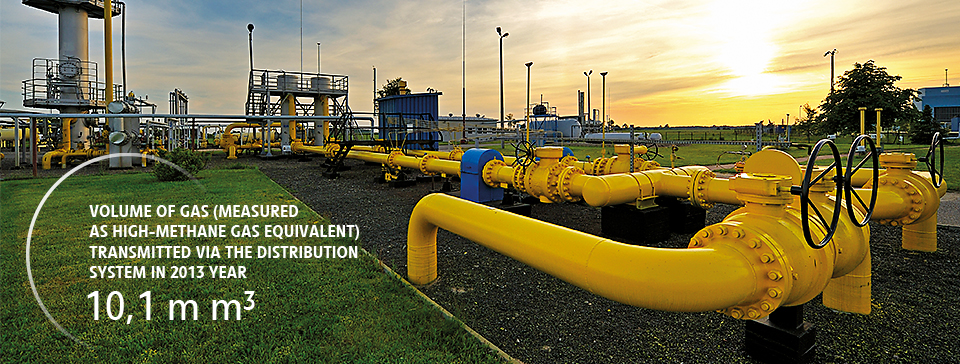Imports
PGNiG is Poland’s largest natural gas importer. Gas is imported primarily from countries east of Poland, and also from Germany and the Czech Republic. With the existing gas infrastructure in place, it is possible to import natural gas from the following directions:
- East – through cross-border connections in Drozdovitse and Zosin (on the Polish-Ukrainian border), Kondratki, Vysokoye and Teterovka (on the Polish-Belarusian border);
- West – through the cross-border connection in Lasów and using the virtual reverse flow service on the Yamal pipeline;
- South – through the cross-border connection in Branice or, alternatively, in Głuchołazy, and a newly built interconnector pipeline in the Cieszyn area connecting the gas systems of Poland and the Czech Republic.
In 2013, the volume of PGNiG’s imports to Poland reached approximately 10,850.03 m m³ of high-methane gas, including:
- 8,733.31 m m³ (80.49%) – from OOO Gazprom Export;
- 353.58 m m³ (3.26%) – from Verbundnetz Gas AG (VNG);
- 552.64 m m³ (5.09%) – from Vitol SA;
- 1,210.26 m m³ (11.16%) – from PGNiG Sales & Trading;
- 0.24 m m³ (0.00%) – from Severomoravska plynarenska.
In 2013, PGNiG continued to use the virtual reverse flow on the Yamal gas pipeline.
It submitted a request to OGP Gaz-System SA for the virtual reverse flow service on the Yamal gas pipeline in the period from January 2012 to December 2015. Following allocation of the available capacity of the Polish section of the Yamal pipeline to the long-term reverse flow service, OGP Gaz-System SA and PGNiG entered into an agreement on the provision of the reverse flow service on an interruptible basis. The contracted capacities are used to transport natural gas purchased on the German market (VTP Gaspool), which is relatively less expensive than gas purchased under the Yamal contract.
Following the completion in 2011 of the upgrade work on the existing (two-way) connection on the Polish-German border in Lasów, its throughput capacity was expanded. As a result, the annual capacity for importing natural gas from Germany has increased by approximately 0.5 bn m³, to a total of approximately 1.5 bn m³. The increased throughput capacity at the Lasów point became available in January 2012.
The system connections (the Lasów terminal and the connection with the Czech Republic, near Cieszyn, commissioned in 2011) play a very important role in ensuring Poland’s energy security, and may also be used for potential emergency supplies. Further, the connections support free trade flows between EU countries, fostering greater economic integration of member states.
In addition, Polskie LNG SA (a wholly-owned subsidiary of OGP Gaz-System SA) is constructing an LNG terminal in Świnoujście. In the initial phase (to 2014), the terminal’s capacity will amount to 5 bn m³ of gas. The contracted annual supplies of 1 m tonnes of liquefied natural gas (approximately 1.34 bn m³) are due to commence towards the end of 2014.
Capex projects
The 2013 Capex of the Trade and Storage segment amounted to PLN 472 m. Key projects focused on the construction and extension of underground gas storage facilities, and included:
- completion of the above-ground section of the Wierzchowice Underground Gas Storage Facility (UGS) and launch of the gas injection and withdrawal cycle, and technical acceptance of the facility;
- completion of the above-ground section and leaching installation together with pipeline for brine discharge, completion of the leaching process of two of the first five caverns at the Kosakowo Underground Gas Storage Cavern Facility (UGSC), and launch of the trial operation of the facility to determine its technical parameters and operating profile;
- continued leaching work at the Mogilno Underground Gas Storage Cavern Facility (caverns Z-15, Z-16, and Z-17) and hydrostatic test of the Z-13 cavern;
- extension of the Husów Underground Gas Storage Facility up to 500 m m³ of storage capacity.
Furthermore, the construction of the above-ground section and leaching installation with pipeline for brine discharge, and leaching process of two of the first five caverns, was completed at the Kosakowo Underground Gas Storage Cavern Facility in 2013. Trial operation of the facility was also launched to determine its technical parameters and operating profile. In December 2013, final acceptance of the facility (consisting of two caverns with an approximate capacity of 61 m m³) took place. The expenditure incurred in 2013 was close to PLN 139 m, and the project was EU co-financed.
Storage facilities
PGNiG owns nine underground gas storage facilities, located in two different types of geological structures – salt caverns (underground gas storage cavern facilities) or depleted gas and oil reservoirs. Seven of them are used for high-methane gas storage (Wierzchowice UGS, Husów UGS, Mogilno UGSC, Strachocina UGS, Swarzów UGS and Brzeźnica UGS, and two caverns are also undergoing testing for natural gas injection at the Kosakowo UGSC), while the other two are nitrogen-rich gas storage facilities (Daszewo UGS and Bonikowo UGS).
Mogilno Underground Gas Storage Cavern Facility – a high-methane gas storage site with a working capacity of 407.89 m m³, located in the county of Mogilno (Bydgoszcz province), municipalities of Mogilno and Rogowo. The facility is located in salt caverns, allowing high injection and withdrawal capacities. Mogilno is currently being extended to a target storage capacity of 800 m m³.
Husów Underground Gas Storage Facility – a high-methane gas storage site with a working capacity of 350 m m³. It is located in the county of Łańcut (Rzeszów province), municipalities of Łańcut and Markowa. The facility’s working capacity is currently being extended to 500 m m³.
Wierzchowice Underground Gas Storage Facility – a high-methane gas storage site. It is located in a partially depleted nitrogen-rich gas reservoir, in the county of Milicz (Wrocław province), municipalities of Milicz and Krośnice. With a working capacity of 1,200 m m³, it is the largest underground gas storage facility in Poland.
Strachocina Underground Gas Storage Facility – a high-methane gas storage site with a working capacity of 360 m m³. It is located in the county of Sanok (Rzeszów province), municipalities of Sanok and Brzozów.
Brzeźnica Underground Gas Storage Facility – a high-methane gas storage site with a working capacity of 65 m m³. The facility is located in the county of Dębica (Rzeszów province), municipality of Dębica. Its working capacity is currently being extended to 100 m m³.
Swarzów Underground Gas Storage Facility – a high-methane gas storage site with a working capacity of 90 m m³. It is located in the county of Dąbrowa Tarnowska (Kraków province), municipalities of Dąbrowa Tarnowska and Olesno. Swarzów is one of the oldest gas storage facilities in Poland.
Bonikowo Underground Gas Storage Facility – a storage site for Lw nitrogen-rich gas with a working capacity of 200 m m³. The role of the Bonikowo facility, commissioned in 2010, is to help optimise the production of Lw nitrogen-rich gas in western Poland, which is why it is not a storage facility within the meaning of the Polish Energy Law.
Daszewo Underground Gas Storage Facility – a storage site for Ls nitrogen-rich gas with a working capacity of 30 m m³, located in a partially depleted crude oil and nitrogen-rich gas reservoir. As Daszewo is used to optimise production, it is not classified as a storage facility within the meaning of the Polish Energy Law.
Another storage facility in salt caverns is under construction:
Kosakowo Underground Gas Storage Cavern Facility – a high-methane gas storage site in the vicinity of the Gdańsk-Gdynia-Sopot metropolitan area. In December 2013, the first two caverns of the facility, having a total working capacity of 51.2 m m³, underwent final acceptance and the capacity will be made available in the storage year of 2014/2015. The facility’s target working capacity is 250 m m³. Completion of the Kosakowo UGSC project is scheduled for 2021.
Short-term peak fluctuations in demand for natural gas are balanced with supplies from the Mogilno Underground Gas Storage Cavern Facility, where gas is stored in worked-out salt caverns. The Kosakowo UGSC is to serve a similar function.
The capacities of the Wierzchowice UGS, Husów UGS, Strachocina UGS, Swarzów UGS and Brzeźnica UGS facilities are used to balance changes in summer and winter seasonal demands for natural gas, fulfil the obligations of take-or-pay import contracts, ensure the continuity and security of natural gas supplies, and fulfil the obligations of agreements for the delivery of natural gas to customer premises.
The capacities of the Wierzchowice UGS, Husów UGS, Mogilno UGSC and Strachocina UGS facilities are also used by the Group to fulfil the obligation (for companies trading in gaseous fuels with foreign customers) to maintain mandatory stocks of natural gas, imposed by the Polish Act on Stocks of Crude Oil, Petroleum Products and Natural Gas as well as the Rules to be Followed in the Event of Threat to National Fuel Security or Disruptions on the Petroleum Market, dated February 16th 2007.
Working capacities of the underground gas storage facilities in 2013 (m m³)
| Working capacity [m m³] 2013 | Working capacity [m m³] Target capacity | Year extension/construction completed | |
|---|---|---|---|
| High-methane gas | |||
| Brzeźnica | 65 | 100 | 2015 |
| Husów | 350 | 500 | 2014 |
| Kosakowo* | 51.2 | 250 | 2021 |
| Mogilno | 407.9 | 800 | 2027 |
| Strachocina* | 360 | 360 | - |
| Swarzów | 90 | 90 | - |
| Wierzchowice* | 1,200 | 1,200 | - |
| Nitrogen-rich gas | |||
| Bonikowo | 200 | 200 | - |
| Daszewo | 30 | 30 | - |
| * Tests are underway to determine UGS parameters and operating profiles for the new storage capacities. | |||
Location of underground gas storage facilities

In order to fulfil the legal obligation concerning storage system operator separation, PGNiG established a special purpose company, Operator Systemu Magazynowania Sp. z o.o. (OSM), whose core business objects include storage system operator duties for the facilities owned by PGNiG. The company makes available the storage capacities in such a way as to meet market demand for gas storage, while optimising storage facility operation.
In accordance with its licence for gas fuel storage, OSM provides its services at the Brzeźnica UGS, Husów UGS, Mogilno UGSC, Wierzchowice UGS, Strachocina UGS and Swarzów UGS facilities.
Between January 1st and December 31st 2013, OSM made available, under long-term contracts, 380 m m³ of working capacity released following the expiry of earlier contracts, including:
- on an interruptible basis – total of 115 m m³ of working capacity, including:
- 5 m m³ of working capacity at the Strachocina UGS;
- 60 m m³ of working capacity at the Wierzchowice UGS;
- 50 m m³ of working capacity at the Husów UGS;
- on a continuous basis – total of 265 m m³ of working capacity, including:
- 115 m m³ of working capacity at the Wierzchowice UGS;
- 100 m m³ of working capacity at the Husów UGS;
- 50 m m³ of working capacity at the Mogilno UGSC.
A working storage capacity of 21.5 m m³ at the Mogilno UGSC was made available under the short-term interruptible-basis service.
Under the contractual constraints management procedure, covering the storage capacity contracted in 2012, a total of 41.5 m m³ of working capacity was made available at the Mogilno UGSC under long-term continuous-basis contracts.
The entire working capacity offered in the reporting period was allocated.
As at December 31st 2013, OSM had storage facilities with a total capacity of 1,817.9 m m³, of which 1,796 m m³ was allocated under long-term contracts.
Working storage capacities made available in the storage year of 2012/2013
| High-methane gas | Working storage capacities (m m³) |
|---|---|
| Brzeźnica Underground Gas Storage Facility | 65.0 |
| Husów Underground Gas Storage Facility | 350.0 |
| Mogilno Underground Gas Storage Cavern Facility | 407.9(1) |
| Strachocina Underground Gas Storage Facility | 330.0 |
| Swarzów Underground Gas Storage Facility | 90.0 |
| Wierzchowice Underground Gas Storage Facility | 575.0 |
| Total | 1,817.9(2) |
| 1) The amount includes the working capacity made available to OGP Gaz-System SA and working capacities made available on a short-term basis. 2) The new working capacities of the Kosakowo UGSC, Strachocina UGS and Wierzchowice UGS, increased in 2013, are to be made available in the storage year of 2014/2015. |
|
EU programmes
On May 16th 2013, an agreement was signed between PGNiG and the Oil and Gas Institute of Kraków on the co-funding of the Husów UGS extension project. Under the agreement, the maximum contribution to the project is PLN 38,204,250.00, and the expenses eligibility period is from April 12th 2012 to May 31st 2015.
On September 16th 2013, Annex No. 1 to the agreement on the co-funding of the ‘LNG-based conversion of Ełk and Olecko from propane-butane to E-gas’ was executed. Pursuant to the Annex, the maximum contribution to the project is PLN 5,537,680.75, and the expenses eligibility period is from September 1st 2012 to October 31st 2014.
Apart from the above projects, PGNiG proceeded with the following EU-funded projects in 2013:
- Wierzchowice UGS extension;
- Kosakowo UGSC construction.






